
Rio School District - Oxnard, CA CASE STUDY


Rio School District - Oxnard, CA CASE STUDY
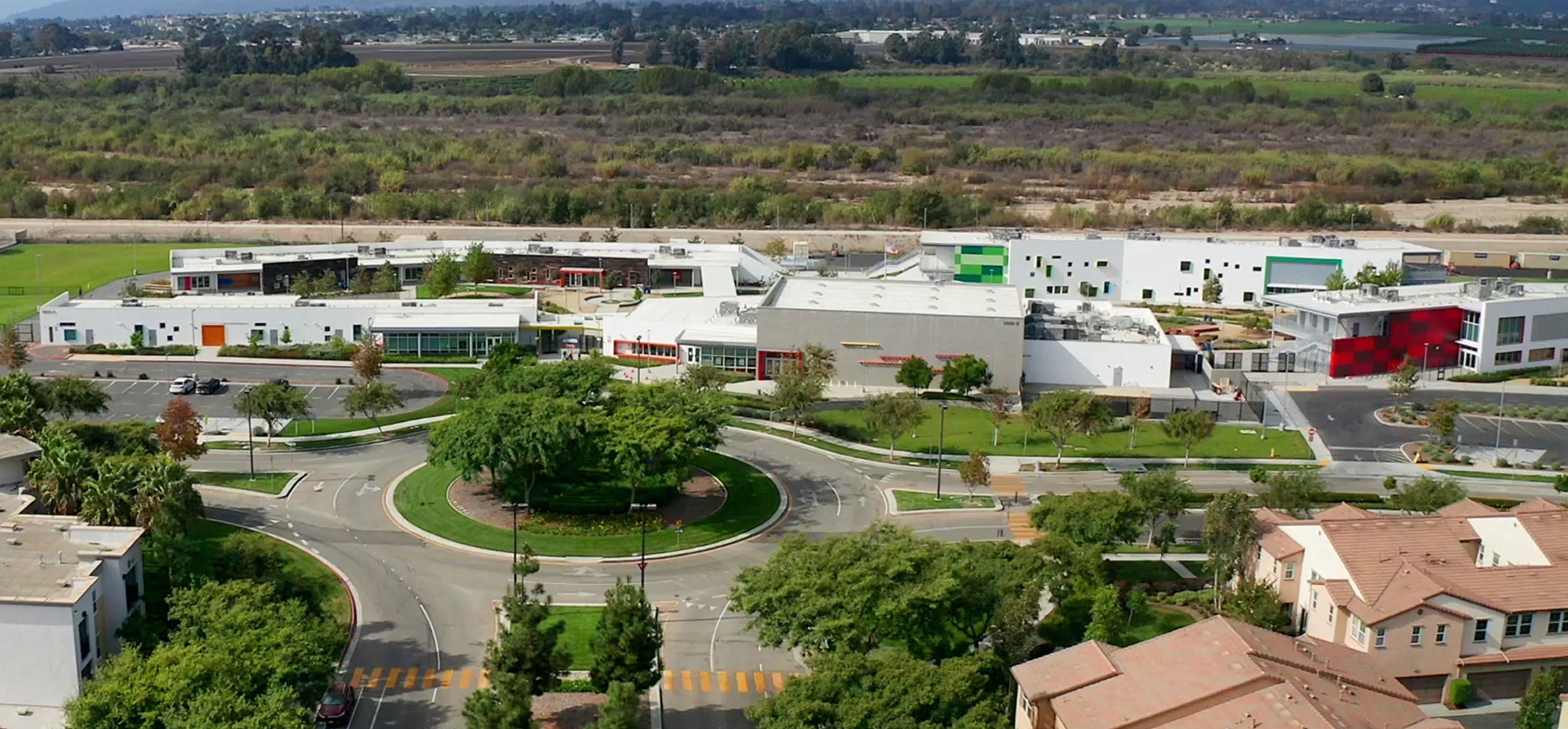

PROJECT DETAILS
OWNER: RIO SCHOOL DISTRICT
LOCATION: OXNARD, CALIFORNIA
OCCUPANCY DATE: AUGUST 2018
GRADES: K - 8
SITE AREA: 12 ACRES
BUILDING AREA: 85,711 SF
STUDENT CAPACITY: 972
KINDERGARTEN
1ST - 2ND GRADE
3RD - 5TH GRADE
6TH - 8TH GRADE
MAKERSPACES
BUILDING
LITERATURE
CERAMICS & PERFORMANCE
SCIENCE & GEOLOGY
CULINARY CENTER
NATURE

ES (1ST-2ND) ES (3RD-5TH) MS (6TH-8TH) ES (3RD-5TH)


KINDERGARTEN, ADMINISTRATION & WELCOME CENTER

FIRST & SECOND GRADE BUILDING

THIRD – FIFTH GRADE BUILDING (SOUTH ELEVATION OF TYPICAL 2-STORY BUILDING)

THIRD – FIFTH GRADE BUILDING (NORTH ELEVATION OF TYPICAL 2-STORY BUILDING)




The Rio del Sol STEAM School was designed for ecological sustainability, environmental education/stewardship, and economy – meeting a number of high-performance building criteria.
Passive sustainable strategies include: thoughtful building orientation; natural daylighting; translucent insulated panels to maximize natural light and minimize heat gain; southern exposure punched windows providing deep seating nooks and simultaneously enabling shade; translucent panels in maker-spaces to maximize natural light; tubular skylights in classrooms; natural ventilation and operable windows in each classroom / shared space; and FSC-certified wood and recyclable carpets throughout the campus interiors. Low VOC and reclaimed materials, bioswales, native drought-tolerant plantings, biomes,
sustainable gardens and citrus grove, dry creek pong, butterfly garden, mud-walk, and a green wall further contribute to sustainability goals.
The student-led “Save the Steelhead Trout” initiative is a prime example of promoting environmental stewardship, which is supported through the siting of the buildings and the design of integrated learning activities, including integrated stone splashbeds that make water drainage from the building’s downspouts visible for sustainable strategy teaching moments.
In addition, the design included strategies to promote student health and wellness, by providing a culinary center and garden; and also integrated opportunities to protect the adjacent Santa Clara River.

RECLAIMED WOOD
NATIVE WILDFLOWERS
GATEWAY TO THE SANTA CLARA RIVER BIOSWALES
DRY CREEK POND
OUTDOOR STAGE
GREEN WALL BERM FOR CLOUD-GAZING
RIVER ACCESS
STORY TREE
DOWNSPOUT SPLASHBED FEEDS BIOSWALE
MUD WALK

Southern Exposure
CHUMASH NATIVE PLANTING BIOMES
North-Eastern Exposure
MIDDLE SCHOOL ENTRY
MAIN CAMPUS ENTRY
SOUTHERN WINDOW ORIENTATION TO MINIMIZE HEAT GAIN DROUGHT TOLERANT PLANTING
BUTTERFLY GARDEN

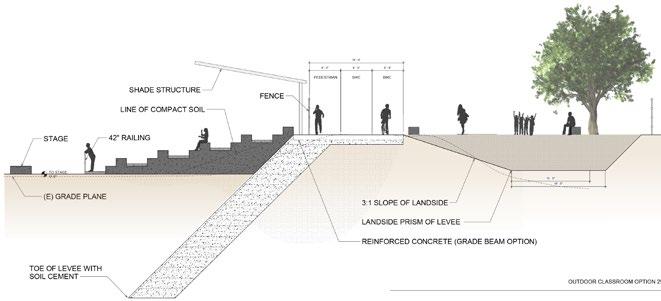
SANTA CLARA RIVER EDUCATIONAL BETTERMENTS: COLLABORATION WITH THE WATERSHED PROTECTION DISTRICT


CULINARY CENTER & GARDEN: PROMOTING WELL-BEING FOR MIND & BODY
The Rio del Sol STEAM School is a new 900-student K-8 campus in Oxnard, California that provides a one-of-a-kind educational experience to a largely underserved and migrant population. It is the first K-8 campus for the Rio School District and the first STEAM School for Ventura County.
When it comes to school design, we often celebrate innovative architecture, a flexible curriculum, or partnership with the community. While ‘checking all the boxes’ for these traditional measures of award-worthiness, the new Rio del Sol K-8 STEAM School goes a step beyond. The project merits recognition because of its holistic design approach –where pedagogy and architecture combine, to create an unprecedented educational experience that is continuously evolving.
Realizing a vision set by Rio School District Superintendent Dr. John Puglisi of creating learning experiences that value and inspire creativity, culture, and caring, the architecture of the new Rio del Sol School embraces both progressive teaching methods and contextual influences to promote:
• Curiosity – through student-centered, transdisciplinary environments
• Community – through elements relating to ancient Chumash culture
• Soft Skills – through multi-age-interaction and open-choice settings
A meandering path through the campus serves as a metaphor for the ever-evolving, inquiry-based pedagogical model of the school, while responding to the site’s context – it’s adjacency to the Santa Clara River – and answering the question, “How can we help the river find its way for the next 100 years?” Just as a “meander” forms when water erodes and widens a river-bank, the educational meander, dubbed the “River of Knowledge,” offers “carved” nodes of activity, fun, and learning, to broaden the students’ educational journey.
In support of the notion that true learning cannot be prescribed or dictated, but occurs with spontaneity, the new school features immersive, makerspace and STEAM-focused learning environments that encourage freedom of thought, choice, and flexibility. Students have the freedom to learn, play, and teach each other while choosing various tools and settings, regardless of their age.
MAKERSPACES/STEAM
Immersive learning environments at Rio del Sol School are created through strong indoor/ outdoor relationships. Each classroom-lab opens up to indoor or outdoor makerspaces, while providing access to the educational meander. The indoor-outdoor integration of focused makerspaces for building, literature, fine arts, performance, science, and nature provides all students with access to specialized, hands-on/minds-on educational tools and settings.
Without a doubt, this project is worthy of recognition as a stellar example of supporting a new model for learning within a dynamic and immersive environment. At the Rio del Sol School, students succeed because they are inspired both by the innovative curriculum/ pedagogical approach and by the architecture and design. Together, the architecture and pedagogy encourage creativity, culture and caring, while emphasizing freedom of choice and a broad variety of interactive learning spaces. Students emerge as empowered, engaged, empathetic individuals prepared to succeed in their educational journeys –and in life.



The Rio del Sol campus is bordered by a community park, a commercial zone, and the Santa Clara River, and is integrated into a new housing development.
Due to the school’s proximity to the Santa Clara River, the site is graded and the buildings are carefully situated in consideration of the 100-year flood plain. All buildings are located south of the 100-foot easement from the Santa Clara River, while still allowing for all hardcourts to be placed on the northern part of the property.

Rio del Sol K-8 STEAM
RIO DEL SOL K-8 STEAM BUSINESS
Business
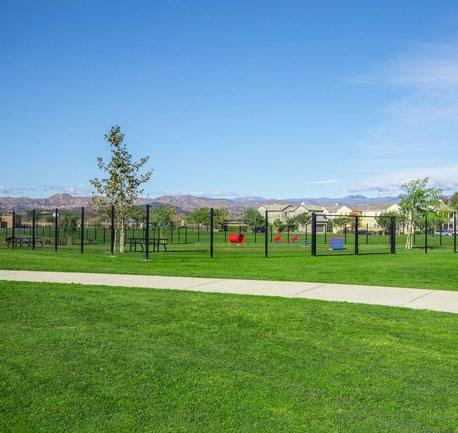

MULTI-FAMILY HOUSING
Multi-family Housing
COMMERCIAL
PARKS
Commercial Parks

River, Ponds, Wetlands
RIVER, PONDS, WETLANDS
AGRICULTURAL FIELDS
Agricultural Fields
Streets, Highways
STREETS, HIGHWAYS
RAILROAD
Railroad
BIKE PATH
Bike Path
BUS STOP
Bus Stop

Responding to the question: “How can we help the river find its way for the next 100 years?,” the design team developed the concept of the “River of Knowledge” – a meandering path that provides nodes of activity, fun, and learning throughout the Rio del Sol campus to enhance the students’ educational journey.
Just as a meander forms in nature when moving water in a stream erodes the outer banks and widens its valley, creating new paths, the Educational Meander flows like a stream that contains everything needed for hands-on /minds-on activities in building, literature, fine art, performance, science,
and nature. Supported by a decentralized plan, the Educational Meander provides all students with equal access to these unique learning environments creatively integrated throughout the campus. Today, students might have class at the outdoor stage; tomorrow, students may go barefoot through the mud-walk; the day after, explore the constellation connect-the-dots installation. At the center of the campus is the Wisdom tree, a place for all to come together to share and to learn.
“Rio del Sol STEAM School is really about the river. The meander, both metaphorically and literally, represents the physical environment and our pedagogical philosophy. Our culture supports freedom of thought – a meandering thought process, if you will – and the path through our campus actually meanders.”
Dr. Ralph Cordova, Principal, Rio del Sol STEAM School




Meander (n): A bend in a sinuous watercourse or river forms when moving water in a stream erodes the outer banks and widens its valley.




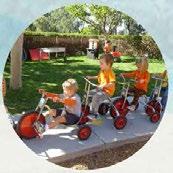










The new Rio del Sol STEAM School serves a diverse local community, largely comprised of an under-served migrant population. The planning process sought to engage both community members and District staff, while also acknowledging, and drawing inspiration from, the site’s history and connections to ancient Chumash culture.
Following referendum approval, the design team engaged community members and District staff to confirm the school’s educational philosophy; inform the building program; and collaboratively envision the types of spaces desired within the new school. Engaging the local community in the planning process, while also developing a solution that would respect the history and culture of the local area was of paramount importance.
“The STEAM school will be designated as an example for the District, County, State, Country, and World.”
Dr John Puglisi, Superintendent, Rio School District
In response to the new campus being sited on ancient Chumash lands, the planning approach uniquely embraced community/cultural influence and site history by engaging Native American Chumash Elder Marcus Lopez early in the process. The campus was planned and designed as a means to learn about the past, the here and now, and the future. Reflecting this commitment, Chumash culture and values were explored in detail as part of the overall community engagement effort. The Chumash Elder was specifically engaged for the following key activities:
• Leading and Participating in Teacher Workshops, Site Visits & Key Meetings
• Providing Input on Planning Concepts that Emphasize Connection to the River and Nature
• Developing the Chumash Diagram of Cosmology and Ideas to Integrate it into the Design
• Providing a Formal Chumash Blessing of the Site Prior to the Start of Construction
• On going collaboration with Rio School District



Given the unique demographics of the student population, the community engagement process was critical to gathering valuable input during the early planning process.
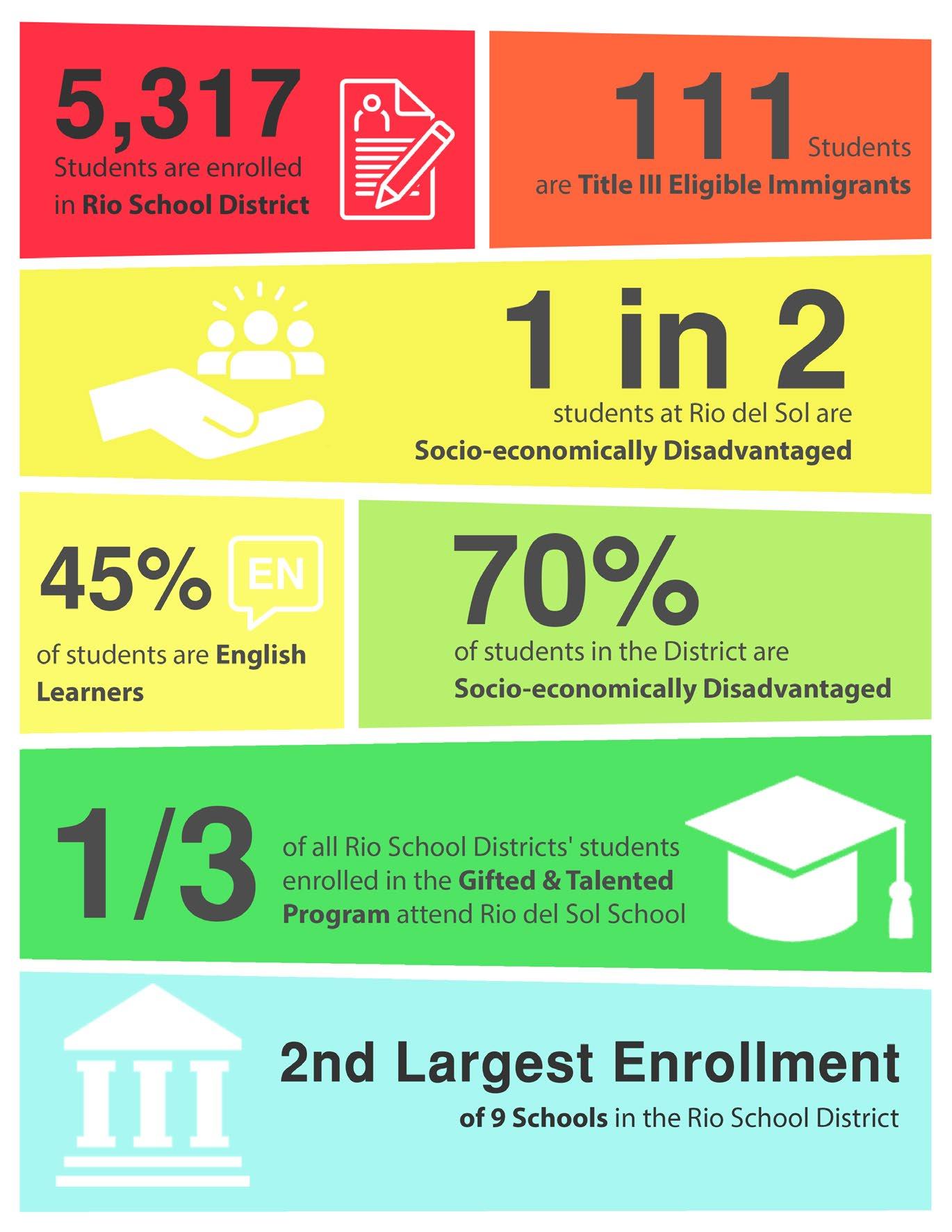
The Diagram of Chumash Cosmology developed during early planning process is integrated throughout the campus. Tapping into these principles, the educational environment incorporates culture- and creativity-inspiring features that have their roots in Chumash Cosmology.
The Skyscape is represented by rainbow-colored louvers at the school entrance; Balance with Nature is depicted by a mural of creatures and plants native to the river; Communal Obligations and concepts of Livelihood are communicated through an herb wall, culinary classroom, vegetable garden, and citrus tree grove; multi-colored lockers that spell out words like “rhythm,” “music,” and “beat” in Morse code, and global numbering systems stamped in concrete, teach Ethno-Mathematics; the “Wisdom Tree” in the center of campus represents Truth & Energy, encouraging students to share discoveries and practice Social Relations; Celestial Navigations are expressed through “constellations” that become visible as dots in the concrete are connected; and Ethno-Science, which combines the study of culture, biology, and nature, is expressed through planting biomes, allowing students to learn why certain plants are critical to society, art, and survival.


















Based on input gathered through the community engagement process, which included visioning sessions, workshops, and tours, a clear set of goals and priorities for the project emerged. The design team developed planning options based on these goals. In addition, the educational curriculum, and both the aesthetic and functional aspects of the physical environment were refined and developed to align with the desires expressed by the community and the Stakeholder / Planning Committee as a whole during the workshop exercises.
“From the beginning, there was a sense that ‘we’re all doing this together’ – equal voices in the planning, creating equal opportunities for students to learn.”
Dr. John Puglisi, Superintendent, Rio School District


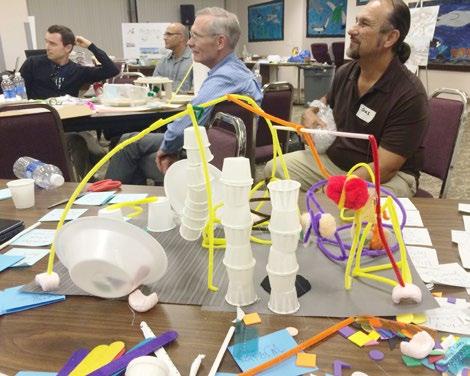



Spaces should promote freedom-centric learning, with a variety of spaces to choose from for individual learning and teaching style
SAFE LEARNING ENVIRONMENT
All spaces shall encourage caring for each other, with broad visibility for supervision, but maintaining intimate feeling






CONNECTION TO NATURE
Seamlessly connect indoor and outdoor learning and teaching, and unite students with themes related to the Santa Clara River
COMMUNITY INTERACTION
Create spaces to provide continued involvement of local community experts in teaching
NATURAL LIGHT
Maximize daylighting with bright spaces and views to the outdoors for every learning environment





Provide interior and exterior spaces to celebrate history, culture and traditions of the community and the contextual site, including the Chumash
COMMUNITY BEACON
Provide a welcoming environment to parents, siblings, and the community at large
SUSTAINABILITY
Passive sustainability strategies should promote students becoming stewards of the environment
Promote health through natural ventilation, edible gardens, hygiene, open space and varied areas of play
LOW MAINTENENCE
Simple building materials and systems that are easy to maintain
Supporting District and Educational Goals, the Rio del Sol STEAM School features two rivers for students to explore and navigate: the Santa Clara River and the “River of Knowledge.” Both are integral to Rio del Sol’s curriculum, the culture of the District, and overall student success. By engaging students with immersive, varied learning environments that encourage freedom of thought, choice, and flexibility, the learning and teaching spaces are evolving organically and simultaneously, showing that the physical space can harmonize and progress with pedagogy and school culture, allowing the educational model to grow and thrive. This is a benefit of a school designed with no traditional barriers—where the architecture and curriculum can live in perfect harmony and constantly inform each other to enhance the student experience.
The students of Rio del Sol STEAM School have come to love and appreciate the special learning environment that has been created for them. In particular, the Educational Meander, which both ‘carves’ the architecture and creates nodes of unexpected activity throughout the campus, reinforcing the school’s freedomcentric approach, is a very well-received design element.
Students are encouraged to explore these carved-out areas along the Meander – from the circular natural seating space around the Wisdom Tree, to unusual hardscape features, nature-inspired settings, and serene, meditative spaces. The freedom of choice presented by the Meander has become a theme for the school, with students embracing this motto by wearing t-shirts that say, “I’m not lost, I’m meandering.”
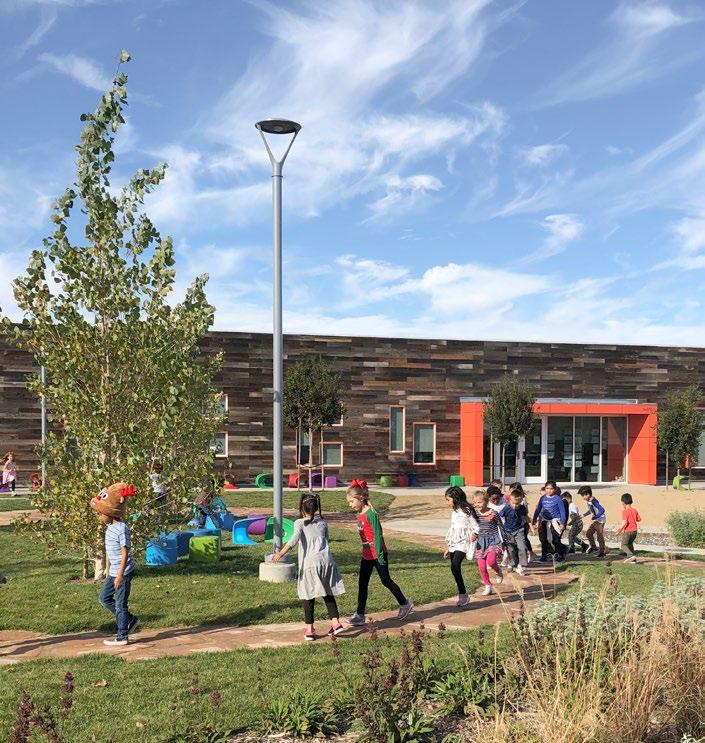
The community engagement process that was key to development of the new Rio del Sol STEAM School did not stop with the school being built. Rio School District is committed to ongoing community engagement, and actively encourages parent involvement by providing resources and access to the new school’s facilities. The school plays host to community events; serves as a venue for dance recitals, workshops, and other public/ semi-public events; and is actively soughtout by the community due to its open space, promenades, and multi-purpose environments.


“Rio del Sol School is about light, openness, air, valuing the outside as much as the inside, and disturbing –or disrupting – the separation between the two… connecting classrooms/learning labs, STEAM education and makerspaces seamlessly and purposefully, to create a free-flowing learning environment.”
Puglisi,